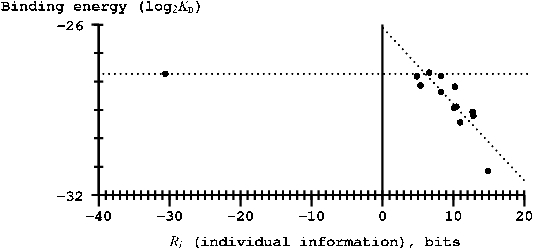
fisbc: Correlation between binding rate constants and individual information of E. coli Fis binding sites



| Significance of the "Breakpoint Paper": The binding rate constants and binding energy curves break at zero bits of information. This observation implies that the DNA binding protein interaction is a multi-dimensional coded system rather than a single dimensional chemical system as usually proposed in standard thermodynamics and biochemistry. |
| Summary: A breakpoint in the DNA binding energy/information curve shows that DNA binding is coded and not a simple binding reaction. |
| Background: Information theory is well suited to studying DNA binding by proteins, and this is generally recognized by the wide use of sequence logos, which were invented in this laboratory. The theory is about averages and not necessarily about the kinetics of binding. However, if the on-rate is essentially constant because the protein binds when it is close to its site, then the log of the off-rate should be related to the information in a binding site. In collaboration with Robert Fisher's laboratory, we tested this hypothesis on the Fis protein which we had characterized previously. |
|
Advance:
We discovered that the log of the off rate is indeed related to the
information in a binding site, but so is the on-rate. We believe that
the Fis protein requires DNA bending and that DNA bendability is
related to the information in the binding site.
We also observed that the linear relationship between the log of the off rate (or the binding energy) and the information 'breaks' at zero bits of information. This result is expected from a version of the Second Law of Thermodynamics which predicts that sequences that bind a protein have positive information while those that are not sites have information less than zero. The break in the curve at this point indicates that the theory is correct. Previous models of DNA binding do not predict the breakpoint. |
| Implications: In 1949, Claude Shannon predicted break effects in communications systems. Observing the same kind of break in DNA binding strongly implies that we can understand DNA/protein interactions using the vast array of mathematical tools used to develop modern communications systems. That is, the result implies that a precise nanotechnology of DNA binding may be possible to engineer using knowledge we already have. The result is general and should apply to any specific interactions between molecules. This is a paradigm shift because the classical view is that molecular interactions are one dimensional. The new view is that the interactions are multidimensional and have evolved codes. If we can crack those codes we will have a general nanotechnology for molecular interactions. |
@article{Shultzaberger.Schneider-spr2007,
author = "R. K. Shultzaberger
and L. R. Roberts
and I. G. Lyakhov
and I. A. Sidorov
and A. G. Stephen
and R. J. Fisher
and T. D. Schneider",
title = "{Correlation between binding rate constants and
individual information of \emph{E. coli} Fis binding sites}",
journal = "Nucleic Acids Res.",
volume = "35",
pages = "5275-5283",
pmid = "17617646",
pmcid = "PMC2018646",
note = "\url
{https://doi.org/10.1093/nar/gkm471},
\url
{https://alum.mit.edu/www/toms/papers/fisbc/}",
year = "2007"}
Other pointers:
![]()

Schneider Lab
origin: 2007 Jul 09
updated: 2022 Nov 18
![]()